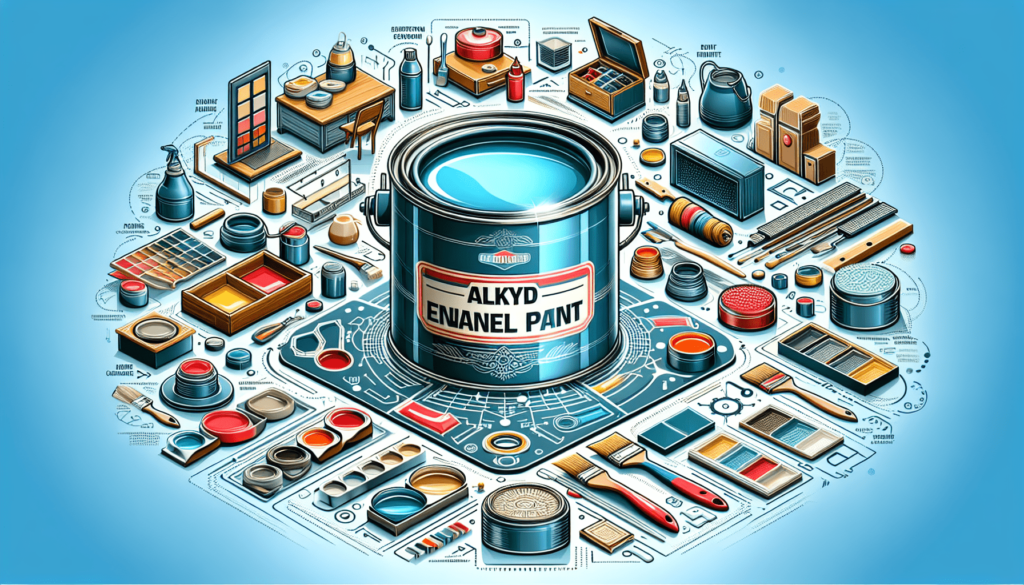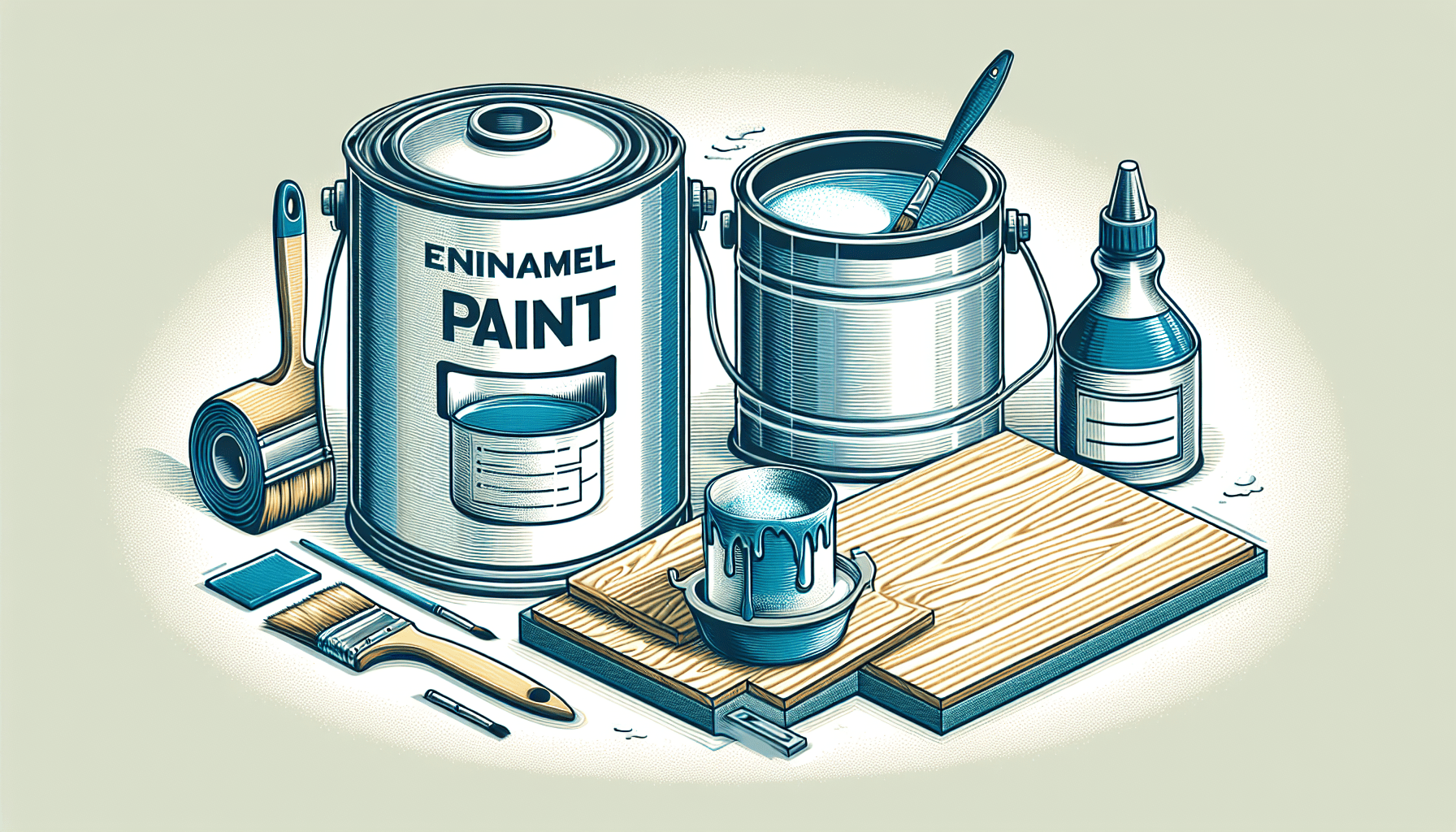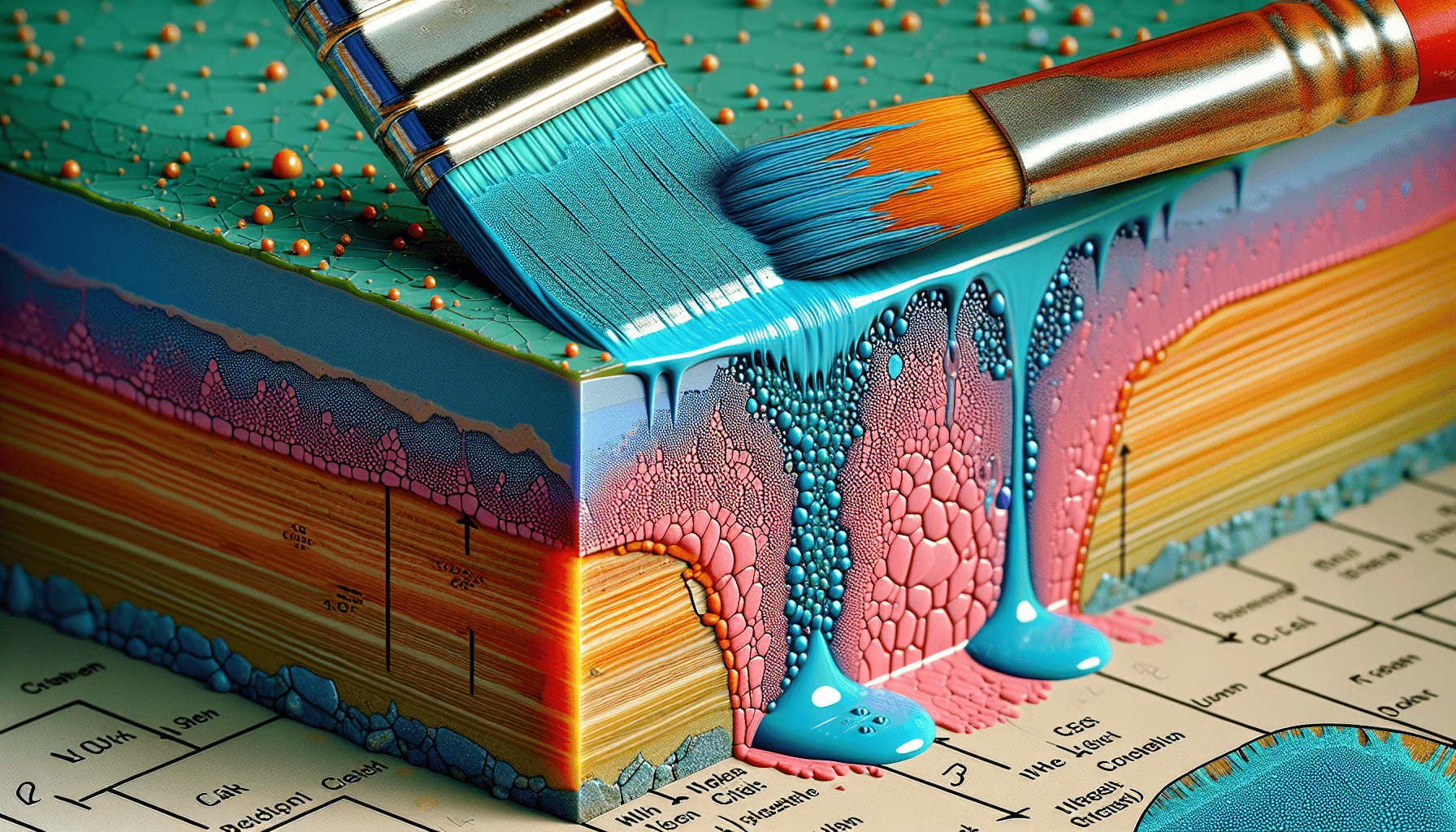Alkyd enamel paint is a highly versatile and widely-used type of paint. Known for its durability and high gloss finish, it is commonly used on surfaces that require a tough and long-lasting coating. Alkyd enamel paint is a synthetic resin-based paint that combines the durability of oil-based paints with the easy application and quick drying time of water-based paints. Its unique composition allows it to adhere well to a variety of surfaces, making it a popular choice for both interior and exterior applications. With its smooth and glossy finish, alkyd enamel paint not only offers superior protection against scratches and weathering, but also provides an aesthetically pleasing look to any project. In this article, we will delve into the various uses, advantages, and considerations of using alkyd enamel paint, shedding light on what makes it stand out as a reliable and versatile option.

Definition of Alkyd Enamel Paint
Alkyd enamel paint is a type of oil-based paint that is popular for its durability, versatility, and glossy finish. It is composed of a base resin mixed with solvents, drying agents, pigments, and additives. This type of paint is commonly used for both decorative and protective purposes on various surfaces, including metal and wood. While it offers many advantages, such as excellent adhesion and resistance to moisture and heat, it also has some disadvantages, such as a strong odor and potential health hazards due to the presence of volatile organic compounds (VOCs).
Composition and Characteristics
Base Resin
The base resin in alkyd enamel paint is responsible for providing adhesion and durability. There are different types of base resins used, including alkyd resin, oil-based resin, polyester resin, and urethane resin. These resins contribute to the overall texture, flow, and drying time of the paint.
Solvents
Solvents are added to alkyd enamel paint to help with thinning and improve the flow and application of the paint. Common solvents used include mineral spirits, turpentine, naphtha, and xylene. These solvents evaporate during the drying process, leaving behind a smooth and even finish.
Drying Agents
Drying agents, also known as drying oils, are added to alkyd enamel paint to speed up the drying time. They help the paint cure and harden, allowing for quicker recoating and reducing the risk of smudges or smears. Some common drying agents used are Japan drier, cobalt drier, and manganese drier.
Pigments and Additives
Pigments give alkyd enamel paint its color and opacity. Titanium dioxide and iron oxides are frequently used pigments, providing a wide range of colors and hues. Additives such as extenders, anti-skinning agents, and anti-foaming agents may also be included to enhance the paint’s performance and application properties.
Volatile Organic Compounds (VOCs)
Volatile organic compounds (VOCs) are chemicals present in alkyd enamel paint that can be released into the air during application and drying. These compounds can have adverse effects on human health and the environment. It is important to take necessary precautions, such as using proper ventilation and wearing protective equipment, when working with alkyd enamel paint.
Gloss Levels
Alkyd enamel paint is available in different gloss levels, ranging from high gloss to matte. The choice of gloss level depends on the desired finish and the specific application. High gloss provides a shiny and reflective surface, while matte offers a more subtle and non-reflective look. Semi-gloss and satin options offer a balance between the two.
Common Uses
Decorative and Protective Coatings
Alkyd enamel paint is commonly used for both decorative and protective purposes. Its durable and long-lasting properties make it an ideal choice for coating surfaces that require resistance to wear and tear, such as walls, furniture, and cabinets. It provides a smooth and glossy finish that enhances the appearance of the coated surfaces.
Interior and Exterior Applications
Alkyd enamel paint can be used for both interior and exterior applications. It exhibits excellent adhesion to various substrates and can withstand exposure to different weather conditions and UV radiation. Whether it’s for painting walls, trim, doors, or outdoor structures, alkyd enamel paint offers reliable performance and protection.
Metal Surfaces
Alkyd enamel paint is particularly well-suited for coating metal surfaces. It forms a protective barrier against corrosion, preventing rust and deterioration. Metal furniture, railings, appliances, and machinery can benefit from alkyd enamel paint’s durability and resistance to moisture and heat.
Wood Surfaces
Wood surfaces can also be effectively coated with alkyd enamel paint. It penetrates the wood grain, providing a protective layer against moisture, mold, and mildew. Alkyd enamel paint can be used on wooden furniture, doors, trim, and even outdoor decks and fences.
Industrial Equipment
In industrial settings, alkyd enamel paint is commonly used to coat machinery and equipment. Its durability and resistance to chemicals and abrasion make it suitable for high-wear areas. Alkyd enamel paint can withstand the harsh conditions of industrial environments, providing long-lasting protection.
Automobiles and Machinery
Alkyd enamel paint is widely used in the automotive industry for painting cars, trucks, and motorcycles. It offers excellent color retention, gloss, and resistance to fading caused by UV exposure. Additionally, its quick drying time allows for efficient production and faster turnaround times in the automotive and machinery sectors.
Advantages
Excellent Durability
One of the primary advantages of alkyd enamel paint is its exceptional durability. It forms a strong and protective coating that can withstand daily wear and tear. This makes it a suitable choice for surfaces that require long-lasting protection, such as walls, furniture, and machinery.
Superior Adhesion
Alkyd enamel paint exhibits excellent adhesion to various substrates, including metal, wood, and plastic. It forms a strong bond with the surface, ensuring a durable and long-lasting finish. This adhesion prevents peeling, chipping, and flaking over time.
Quick Drying Time
Compared to other paint types, alkyd enamel paint has a relatively quick drying time. This means less waiting time between coats and faster completion of painting projects. The quick drying time also reduces the risk of smudges or smears during application.
Resistance to Moisture and Heat
Alkyd enamel paint offers good resistance to moisture and heat. It forms a protective barrier that helps prevent damage caused by water, humidity, and extreme temperatures. This makes it suitable for both interior and exterior applications.
Wide Range of Colors
Alkyd enamel paint comes in a wide range of colors, offering versatility and options for different design preferences. Whether you prefer bold and vibrant colors or more subtle and neutral tones, there is a color option available to suit your needs.
Overall Versatility
With its ability to adhere to various surfaces and withstand different environments, alkyd enamel paint is a versatile option for many applications. It can be used for both decorative and protective purposes, making it a popular choice among homeowners, professional painters, and industrial professionals alike.

Disadvantages
Strong Odor
One of the main disadvantages of alkyd enamel paint is its strong odor. The solvents and volatile organic compounds (VOCs) present in the paint can emit a harsh odor during application and drying. Proper ventilation and the use of respiratory protection are necessary when working with this type of paint to minimize exposure to the odor.
Potential Health Hazards
The presence of volatile organic compounds (VOCs) in alkyd enamel paint can pose potential health hazards. Prolonged exposure to these compounds can cause respiratory irritation, headaches, dizziness, and other health effects. It is important to follow safety guidelines and use protective equipment when working with alkyd enamel paint.
Expensive Compared to Latex Paints
Alkyd enamel paint tends to be more expensive compared to latex paints. The higher cost is due to the materials used in its composition and its durability. While alkyd enamel paint offers long-lasting performance, it may not be the most cost-effective option for every project.
Longer Cleanup Time
Cleaning up after using alkyd enamel paint can be more time-consuming compared to water-based paints. The solvents used in thinning and cleaning the equipment require thorough cleaning and disposal procedures. It is important to follow proper safety precautions and disposal guidelines when handling the solvents.
Limited Availability
Alkyd enamel paint may not be as readily available as other paint types. While it can be found in most paint stores and home improvement centers, the color options and specific formulations may be more limited compared to latex or acrylic options. However, the availability of alkyd enamel paint can vary depending on the region and local suppliers.
Base Resin in Alkyd Enamel Paint
Alkyd Resin
Alkyd resin is the most commonly used base resin in alkyd enamel paint. It is a synthetic resin that provides excellent durability, adhesion, and resistance to weathering. Alkyd resins are derived from the condensation reaction between polyols or fatty acids and anhydrides or acids. These resins contribute to the overall performance of the paint, including its flow, gloss, and drying time.
Oil-Based Resin
Oil-based resins, also known as alkyd oils, are derived from natural oils and fatty acids, such as linseed oil or soybean oil. These resins offer good adhesion and durability, making them suitable for various applications. They are often used in traditional oil-based paints and stains.
Polyester Resin
Polyester resin is a type of base resin used in alkyd enamel paint. It is a synthetic resin made through the reaction of polyols and polyacids. Polyester resins provide good flexibility, chemical resistance, and adhesion. They are commonly used in industrial coatings and automotive paints.
Urethane Resin
Urethane resin, also known as polyurethane resin, is occasionally used as a base resin in alkyd enamel paint. It is a synthetic resin made from the reaction of isocyanates and polyols. Urethane resins offer exceptional durability, chemical resistance, and flexibility. They are commonly used in high-performance coatings for automotive, marine, and industrial applications.
Solvents Used
Mineral Spirits
Mineral spirits, also known as white spirits or paint thinner, are commonly used as solvents in alkyd enamel paint. They help thin the paint and improve its flow during application. Mineral spirits are derived from petroleum and provide effective cleaning properties when it comes to paintbrushes and other equipment.
Turpentine
Turpentine is another solvent that can be used in alkyd enamel paint. It is derived from pine trees and offers similar thinning and cleaning properties as mineral spirits. Turpentine has a distinct odor and is often preferred by artists for its ability to mix well with oil-based paints.
Naphtha
Naphtha is a fast-evaporating solvent that can be used in alkyd enamel paint. It is derived from petroleum and provides quick drying properties. Naphtha is often preferred in industrial applications where fast production and drying times are required.
Xylene
Xylene is a strong solvent that can be used in alkyd enamel paint. It helps with thinning the paint and enhancing its flow. Xylene is often used in industrial coatings and can dissolve various types of resins and polymers. However, it should be used with caution due to its high toxicity and flammability.
Drying Agents
Japan Drier
Japan drier is a commonly used drying agent in alkyd enamel paint. It is a mixture of metal salts, such as lead, cobalt, and manganese, that accelerates the drying process. Japan drier helps reduce the drying time of the paint, allowing for faster recoating and minimizing the risk of smudging or sticking.
Cobalt Drier
Cobalt drier is another drying agent used in alkyd enamel paint. It contains cobalt salts, which promote the oxidation and polymerization of the paint film. Cobalt drier is effective in speeding up the drying time and improving the hardness of the paint.
Manganese Drier
Manganese drier is a drying agent that contains manganese salts. It is commonly used in alkyd enamel paint to enhance drying and curing. Manganese drier helps the paint film harden and reduces the tackiness during the drying process.
Pigments and Additives
Titanium Dioxide
Titanium dioxide is a white pigment commonly used in alkyd enamel paint. It provides opacity, brightness, and excellent hiding power. Titanium dioxide is resistant to UV radiation and offers good durability, making it suitable for both interior and exterior applications.
Iron Oxides
Iron oxides are pigments that provide a wide range of color options for alkyd enamel paint. They can give various shades of red, yellow, and brown, depending on the specific iron oxide used. Iron oxide pigments offer good color stability and weather resistance.
Zinc Oxide
Zinc oxide is a white pigment that can be used in alkyd enamel paint. It provides excellent coverage and opacity. Zinc oxide is often used as a corrosion inhibitor, as it can help protect metal surfaces from rust and deterioration.
Extenders
Extenders, such as calcium carbonate or talc, are additives that are used to increase the volume and coverage of alkyd enamel paint. They help reduce the amount of pigment needed while maintaining the desired consistency and performance of the paint.
Anti-Skinning Agents
Anti-skinning agents are additives that prevent the formation of a skin or film on the surface of the paint when exposed to air. They help maintain the integrity of the paint, allowing for extended storage and preventing wastage or drying out of the paint in the container.
Anti-Foaming Agents
Anti-foaming agents are additives that reduce or eliminate foaming during the application of alkyd enamel paint. Foam can negatively affect the finish and result in an uneven surface. Anti-foaming agents help ensure a smooth and bubble-free application.
Gloss Levels
High Gloss
High gloss alkyd enamel paint offers a shiny and reflective finish. It provides a smooth and polished appearance, enhancing the vibrancy of the colors. High gloss paint is often used for surfaces that require a more luxurious and eye-catching look, such as doors, trim, and furniture.
Semi-Gloss
Semi-gloss alkyd enamel paint offers a balance between high gloss and matte finishes. It provides a subtle sheen and is less reflective than high gloss paint. Semi-gloss paint is commonly used on surfaces that require a durable and washable finish, such as kitchen cabinets, bathrooms, and woodwork.
Satin
Satin alkyd enamel paint offers a soft sheen that falls between semi-gloss and matte finishes. It provides a smooth and velvety appearance. Satin paint is often preferred for walls and surfaces that require a more subtle and elegant finish, such as bedrooms, living rooms, and hallways.
Matte
Matte alkyd enamel paint offers a non-reflective and flat finish. It provides a smooth and velvety texture without any shine. Matte paint is often used for surfaces with imperfections or for a more modern and contemporary look. It can be suitable for walls, ceilings, and certain decorative elements.
In conclusion, alkyd enamel paint is a versatile and durable option for both decorative and protective coatings. Its composition, including the base resin, solvents, drying agents, pigments, and additives, contributes to its performance and characteristics. While it offers advantages such as excellent durability, superior adhesion, quick drying time, and resistance to moisture and heat, it also has disadvantages, including a strong odor, potential health hazards, higher cost compared to latex paints, longer cleanup time, and limited availability. Understanding the various components and properties of alkyd enamel paint can aid in making informed decisions when choosing the right paint for specific projects.



